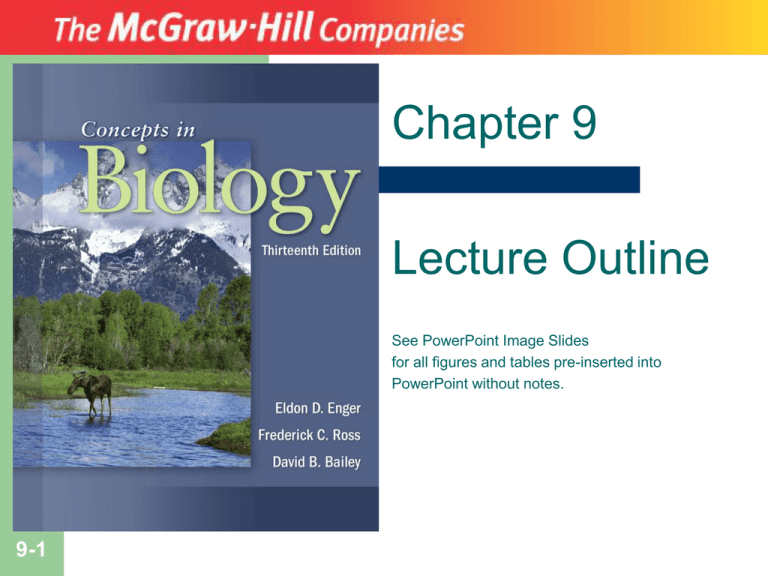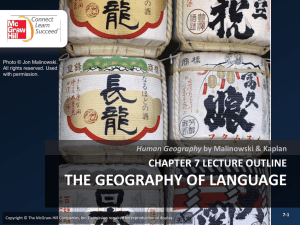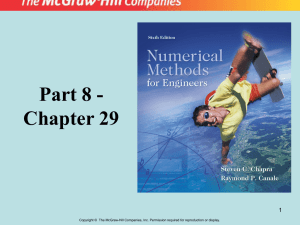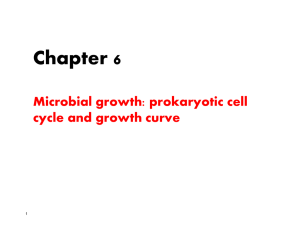
Chapter 9
Lecture Outline
See PowerPoint Image Slides
for all figures and tables pre-inserted into
PowerPoint without notes.
9-1
The Importance of Cell Division
The ability to grow and reproduce are two
fundamental qualities of life.
During cell division, one cell becomes two new
cells.
–
–
–
–
9-2
Accomplishes growth and reproduction
Reproduction occurs as binary fission in prokaryotes.
Growth and some reproduction occurs as mitosis in
eukaryotes.
Reproduction often involves meiosis in eukaryotes.
All cell division is preceded by DNA replication.
Copyright © The McGraw-Hill Companies, Inc. Permission required for reproduction or display.
Uses of Binary Fission
and Mitosis
In single-celled organisms
–
In multi-cellular organisms mitosis:
–
–
–
9-3
Mitosis and binary fission are means of asexual
reproduction.
Causes growth by increasing the number of cells
Replaces lost cells
Repairs injuries
Copyright © The McGraw-Hill Companies, Inc. Permission required for reproduction or display.
Uses of Meiosis
Sexual reproduction involves the donation of
genetic information from two parents.
–
Meiosis occurs prior to sexual reproduction.
–
–
9-4
Each parent can only donate half of the genome.
Generates gametes (egg and sperm) with half of
a genome
The egg and sperm then join during fertilization to
make a unique offspring with a full complement of
genetic information.
Copyright © The McGraw-Hill Companies, Inc. Permission required for reproduction or display.
The Cell Cycle
Eukaryotic cells
–
–
–
9-5
Pass through different
stages between the
time they are “born”
and the time they
divide again
A continuous process
Includes interphase
and mitosis
Copyright © The McGraw-Hill Companies, Inc. Permission required for reproduction or display.
Interphase-G1
During interphase, cells
–
–
Engage in metabolic activities
Prepare for the next cell division
The three phases of interphase
–
G1
9-6
The cell gathers nutrients, carries out its regular
metabolic roles, and performs its normal function.
Commits to divide
Some cells never divide; they stay in G1, called Go..
Prepares for DNA replications
Copyright © The McGraw-Hill Companies, Inc. Permission required for reproduction or display.
Interphase-S
S phase
–
–
–
9-7
DNA replication occurs.
The DNA in chromosomes is
wrapped around histones.
DNA + histones =
chromatin
When S phase is complete
The identical copies are
connected together.
Each is called a sister
chromatid.
– Connected at the
centromere
Copyright © The McGraw-Hill Companies, Inc. Permission required for reproduction or display.
Interphase-G2
During G2
–
–
9-8
Final preparations
are made for
mitosis.
Proteins are made
that will move and
separate the
chromosomes.
Copyright © The McGraw-Hill Companies, Inc. Permission required for reproduction or display.
Mitosis-cell Replication
The two events of cell division
– Mitosis
Separating
the chromosome copies into two
new nuclei
Occurs in four phases that are continuous with
one another
–
Cytokinesis
Dividing
the cytoplasm into two new cells that
will house the new nuclei
9-9
Copyright © The McGraw-Hill Companies, Inc. Permission required for reproduction or display.
Prophase
The thin, tangled
chromatin gradually
coils and thickens.
–
9-10
Becomes visible as
separate chromosomes,
each with two sister
chromatids
Nucleus disassembles.
Nucleolus is no longer
visible.
Copyright © The McGraw-Hill Companies, Inc. Permission required for reproduction or display.
Late Prophase
Spindle fibers attach to
chromosomes at their
centromeres.
–
Spindles are made of
microtubules.
In animals, they form
from the centrioles.
–
–
9-11
Asters form only in
animal cells.
Will move chromosomes
around.
Copyright © The McGraw-Hill Companies, Inc. Permission required for reproduction or display.
Metaphase
The spindle fibers move the
chromosomes so that they are all
arranged at the middle of the cell.
–
–
9-12
This is called the equatorial plate.
Chromosomes complete this process at
metaphase.
Copyright © The McGraw-Hill Companies, Inc. Permission required for reproduction or display.
Metaphase
9-13
Copyright © The McGraw-Hill Companies, Inc. Permission required for reproduction or display.
Anaphase
Sister chromatids separate and move toward
opposite poles.
–
What moves the sister chromatids to
opposite poles?
–
–
9-14
Once the sister chromatids are separated, they
are known as daughter chromosomes.
The poles begin to move farther apart.
The kinetochore (proteins attached at the
centromere) pulls the chromatid along the spindle
fiber.
Copyright © The McGraw-Hill Companies, Inc. Permission required for reproduction or display.
Kinetochores
9-15
Copyright © The McGraw-Hill Companies, Inc. Permission required for reproduction or display.
Anaphase
9-16
Copyright © The McGraw-Hill Companies, Inc. Permission required for reproduction or display.
Telophase
9-17
Spindle fibers
disassemble.
Nuclear membranes
form around the two
new sets of
chromosomes.
Chromatin uncoils.
Nucleolus reforms.
The daughter cells
enter interphase again.
Copyright © The McGraw-Hill Companies, Inc. Permission required for reproduction or display.
Cytokinesis
9-18
Separates the two new nuclei
into new cells
Roughly divides the cytoplasm
and its contents in half
Animal cells
– Membrane forms a
cleavage furrow
– Cell pinches into two
Plant cells
– Cell plate is formed.
– A new cell wall is built,
separating the nuclei.
Copyright © The McGraw-Hill Companies, Inc. Permission required for reproduction or display.
Controlling Cell Division
Cells gather information about themselves and their
environment in order to decide whether or not to
divide.
A cell decides whether to proceed through the cell
cycle at checkpoints.
–
9-19
Cells evaluate their genetic health, their location in the body
and the body’s need for more cells.
Poor genetic health, wrong location in the body or overcrowding will cause the cell to wait before dividing.
The opposite signals will trigger the cell to proceed with
division.
Copyright © The McGraw-Hill Companies, Inc. Permission required for reproduction or display.
Genes Regulate the Cell Cycle
Cells use several proteins to function as
checkpoints.
–
These proteins make the decision to proceed through the
cell cycle or to stop.
Two classes of genes that code for checkpoint
proteins
–
Proto-oncogenes
–
Tumor-suppressor genes
9-20
Code for proteins that encourage cell division
Code for proteins that discourage cell division
The balance of these two types of proteins tells the
cell whether or not to proceed with cell division.
Copyright © The McGraw-Hill Companies, Inc. Permission required for reproduction or display.
p53, a Tumor-suppressor Gene
Near the end of G1, the p53 protein identifies if the
cell’s DNA is damaged.
–
–
If the DNA is healthy, the p53 allows the cell to divide.
If the DNA is damaged, p53 activates other proteins that will
repair the DNA.
Mutations in the p53 gene
–
–
Lead to cells that will proceed through the cell cycle with
damaged DNA
Lead to an accumulation of mutations
9-21
If the damage is too severe, p53 will trigger the events of
apoptosis (cell suicide).
If the mutations occur in proto-oncogenes or tumor-suppressor
genes, then cancer will result.
Copyright © The McGraw-Hill Companies, Inc. Permission required for reproduction or display.
p53, a Tumor-suppressor Gene
9-22
Copyright © The McGraw-Hill Companies, Inc. Permission required for reproduction or display.
Cancer
Cancer is caused by a failure to control cell
division.
–
–
Leads to cells that divide too frequently
These cell masses are tumors that can interfere
with normal body functions.
Benign tumors are cell masses that do not fragment and
spread.
Malignant tumors are cell masses that fragment, spread
and invade other tissues.
–
–
9-23
This process is called metastasis.
p53 is mutated in 40% of all cancers.
Leads to other mutations that result in cancer
Copyright © The McGraw-Hill Companies, Inc. Permission required for reproduction or display.
Malignant Tumors Metastasize
9-24
Copyright © The McGraw-Hill Companies, Inc. Permission required for reproduction or display.
Causes of Cancer
Mutagens are agents that damage DNA.
Carcinogens are mutagens that cause
mutations that lead to cancer.
–
Cigarette smoke
9-25
Has been linked directly to p53 mutations
Copyright © The McGraw-Hill Companies, Inc. Permission required for reproduction or display.
Treatment Strategies ̶ Surgery
Surgical removal
– Once tumors are identified they can be
surgically removed.
– Skin cancers and breast cancers are
frequently treated this way.
– If the cancer is spread diffusely,
surgery is not an option.
9-26
Copyright © The McGraw-Hill Companies, Inc. Permission required for reproduction or display.
Treatment Options ̶ Chemotherapy
and Radiation Therapy
Chemotherapy
–
–
Some drugs will target rapidly dividing cells.
Normal cells that divide rapidly will suffer as well.
Weakens the immune system
Causes hair loss
Radiation therapy
–
–
Uses x-rays or gamma rays directed at the tumor
to kill the cancerous cells
Whole-body radiation is used to treat leukemia.
Can lead to radiation sickness
–
9-27
Nausea, hair loss, etc.
Copyright © The McGraw-Hill Companies, Inc. Permission required for reproduction or display.
Determination
and Differentiation
During sexual reproduction, fertilization of an egg by
a sperm results in a single-celled zygote.
– The zygote undergoes mitosis to develop into an
adult.
– As mitosis occurs, cells must become specific cell
types.
9-28
All cells are genetically identical.
Cells differ in the genes they express.
Determination is the process a cell goes through to select
which genes it will express, committing itself to becoming a
certain cell type.
When a cell is fully developed into a specific type of cell, it is
said to be differentiated.
Copyright © The McGraw-Hill Companies, Inc. Permission required for reproduction or display.
Determination and
Differentiation of Skin Cells
9-29
Copyright © The McGraw-Hill Companies, Inc. Permission required for reproduction or display.
Cell Division and Sexual
Reproduction
Egg and sperm only have half of the individual’s
genetic information.
–
Somatic cells have two sets of chromosomes.
–
Haploid
Meiosis makes haploid gametes.
–
–
9-30
Diploid
Gametes have one set of chromosomes.
–
When egg and sperm join during fertilization, the zygote
receives half of its chromosomes from the egg and half from
the sperm.
Eggs are made in ovaries (animals) and pistils (plants).
Sperm are made in testes (animals) and anthers (plants).
Copyright © The McGraw-Hill Companies, Inc. Permission required for reproduction or display.
Haploid and Diploid Cells
9-31
Copyright © The McGraw-Hill Companies, Inc. Permission required for reproduction or display.
Life Cycles Involving Meiosis
and Mitosis
9-32
Copyright © The McGraw-Hill Companies, Inc. Permission required for reproduction or display.
Pairs of Chromosomes
Diploid cells have two sets of chromosomes.
–
Homologous chromosomes
–
–
–
Have the same order of genes along their DNA
Are the same size; have the centromere in the
same location
One chromosome in the pair came from mom; the
other came from dad.
Non-homologous chromosomes
–
9-33
One set from each parent
Have different genes on their DNA
Copyright © The McGraw-Hill Companies, Inc. Permission required for reproduction or display.
A Pair of Homologous
Chromosomes
9-34
Copyright © The McGraw-Hill Companies, Inc. Permission required for reproduction or display.
Different Species Have Different
Numbers of Chromosomes
9-35
Copyright © The McGraw-Hill Companies, Inc. Permission required for reproduction or display.
Meiosis-Gamete Production
Involves two cell divisions
–
–
Produces four haploid cells
Meiosis I is the first division.
Preceded by DNA replication
Reduction division
–
–
9-36
Chromosome number reduced from diploid to haploid
Meiosis II is the second division.
Copyright © The McGraw-Hill Companies, Inc. Permission required for reproduction or display.
Meiosis
9-37
Copyright © The McGraw-Hill Companies, Inc. Permission required for reproduction or display.
Meiosis I: Prophase I
Prophase I
–
9-38
Synapsis occurs
Homologous chromosomes move toward one another
and associate with one another.
While associated homologs experience crossing over
– Homologs trade equivalent sections of DNA.
– Mixes up the genes that are passed to the next
generation
Copyright © The McGraw-Hill Companies, Inc. Permission required for reproduction or display.
Meiosis I: Metaphase I
Metaphase I:
–
9-39
The synapsed pairs
of homologous
chromosomes are
moved into position
at the equatorial
plate.
Copyright © The McGraw-Hill Companies, Inc. Permission required for reproduction or display.
Meiosis I: Anaphase I
Homologous pairs separate.
–
–
Chromosome number is reduced from diploid
to haploid.
Since homologous pairs line up randomly at
the equatorial plate,
–
9-40
Homologs move to opposite poles.
Sister chromatids do not separate at this point.
This process is called segregation.
Each pair separates independently of the others.
This is called independent assortment.
Copyright © The McGraw-Hill Companies, Inc. Permission required for reproduction or display.
Anaphase I
9-41
Copyright © The McGraw-Hill Companies, Inc. Permission required for reproduction or display.
Meiosis I: Telophase I
Chromatin uncoils.
Nuclear membrane
reforms.
Nucleoli reappear.
Cytokinesis divides the
two haploid nuclei into
two daughter cells.
–
9-42
Each chromosome still
contains two sister
chromatids.
Copyright © The McGraw-Hill Companies, Inc. Permission required for reproduction or display.
Meiosis I
9-43
Copyright © The McGraw-Hill Companies, Inc. Permission required for reproduction or display.
Meiosis II: Prophase II
9-44
Similar to prophase in
mitosis
Nuclear membrane is
disassembled.
Spindle begins to form.
Copyright © The McGraw-Hill Companies, Inc. Permission required for reproduction or display.
Meiosis II: Metaphase II
9-45
Similar to metaphase in
mitosis
Chromosomes are lined
up at the equatorial
plate.
Copyright © The McGraw-Hill Companies, Inc. Permission required for reproduction or display.
Meiosis II: Anaphase II
Centromeres divide.
Sister chromatids
separate.
–
9-46
Now called daughter
chromosomes
Copyright © The McGraw-Hill Companies, Inc. Permission required for reproduction or display.
Meiosis II: Telophase II
9-47
Similar to telophase and cytokinesis in mitosis
Copyright © The McGraw-Hill Companies, Inc. Permission required for reproduction or display.
Summary of Meiosis II
9-48
Copyright © The McGraw-Hill Companies, Inc. Permission required for reproduction or display.
Mitosis vs. Meiosis
9-49
Copyright © The McGraw-Hill Companies, Inc. Permission required for reproduction or display.
Genetic Diversity ̶
The Advantage of Sex
Sexually reproducing organisms
–
–
–
Need two individuals to reproduce
Reproduce more slowly than asexually
reproducing organisms
Have large genetic diversity
When environmental conditions change, they are more
likely to survive (as compared to asexually reproducing
organisms).
Genetic diversity is due to a difference in genes.
–
9-50
Specific versions of genes are called alleles.
Copyright © The McGraw-Hill Companies, Inc. Permission required for reproduction or display.
Genetic Diversity ̶
The Advantage of Sex
Five factors create genetic diversity by
creating new alleles, or new combinations of
alleles.
–
–
–
–
–
9-51
Mutation
Crossing-over
Segregation
Independent assortment
Fertilization
Copyright © The McGraw-Hill Companies, Inc. Permission required for reproduction or display.
Mutations
9-52
Mutations are changes in the nucleotide
sequence of DNA.
This creates new alleles.
New alleles lead to new forms of proteins.
Increases genetic diversity
Copyright © The McGraw-Hill Companies, Inc. Permission required for reproduction or display.
Crossing-over
The exchange of equivalent portions of DNA
between homologous chromosomes
Occurs during prophase I when
chromosomes are synapsed
Allows new combinations of genetic
information to occur
–
9-53
Each gamete then receives some of your
mother’s and some of your father’s genes on
each chromosome.
Copyright © The McGraw-Hill Companies, Inc. Permission required for reproduction or display.
Synapsis and Crossing-over
9-54
Copyright © The McGraw-Hill Companies, Inc. Permission required for reproduction or display.
The Results of Crossing-over
9-55
Copyright © The McGraw-Hill Companies, Inc. Permission required for reproduction or display.
Crossing-over Separates Linked
Genes
The closer genes are
together on a
chromosome, the less
likely they will be
separated by crossingover.
–
9-56
These genes will be
inherited together.
The farther genes are
apart on a
chromosome, the more
likely they will be
separated by crossingover.
Copyright © The McGraw-Hill Companies, Inc. Permission required for reproduction or display.
Segregation
Alleles on homologous chromosomes
separate during anaphase I.
–
–
Each parent will contribute one allele of each
gene to each gamete.
Consider a person who has two alleles for insulin.
Half of its gametes would get the gene for functional
insulin.
Half of its gametes would get the gene for nonfunctional
gametes.
–
9-57
If this gamete were used during fertilization, and was
joined with a gamete with the same gene, the offspring
would not be able to make functional insulin.
Copyright © The McGraw-Hill Companies, Inc. Permission required for reproduction or display.
Independent Assortment
The segregation of homologous
chromosomes is independent of how other
homologous pairs segregate.
Consider two pairs of chromosomes.
–
9-58
Given the two ways these pairs can line up on the
equatorial plate,
There are four possible combinations of
chromosomes in gametes.
Copyright © The McGraw-Hill Companies, Inc. Permission required for reproduction or display.
Independent Assortment
9-59
Copyright © The McGraw-Hill Companies, Inc. Permission required for reproduction or display.
Fertilization
Due to the large number of possible gametes
resulting from independent assortment,
segregation, mutation and crossing-over,
–
Since gametes join randomly
–
9-60
A large number of different offspring can be
generated from two parents.
The combinations of alleles is nearly infinite.
Copyright © The McGraw-Hill Companies, Inc. Permission required for reproduction or display.
Nondisjunction and
Chromosome Abnormalities
Nondisjunctions occur when homologous
chromosomes do not separate during cell
division.
–
–
Frequently results in the death of the cells
Some abnormal gametes live.
When these gametes participate in fertilization, the
offspring will have an abnormal number of chromosomes.
–
Monosomy describes a cell that has just one of a given pair
of chromosomes.
– Trisomy describes a cell that has three copies of a given
chromosome.
9-61
Copyright © The McGraw-Hill Companies, Inc. Permission required for reproduction or display.
Nondisjunction During
Gametogenesis
9-62
Copyright © The McGraw-Hill Companies, Inc. Permission required for reproduction or display.
Karyotypes are a Picture
of a Person’s Chromosomes
9-63
Copyright © The McGraw-Hill Companies, Inc. Permission required for reproduction or display.
A Karyotype can Reveal
Trisomy 21
Down syndrome
–
–
–
Three copies of
chromosome #21
Results in 47 chromosomes
instead of 46
Symptoms include:
9-64
Thickened eyelids
Mental impairment
Faulty speech
Copyright © The McGraw-Hill Companies, Inc. Permission required for reproduction or display.








